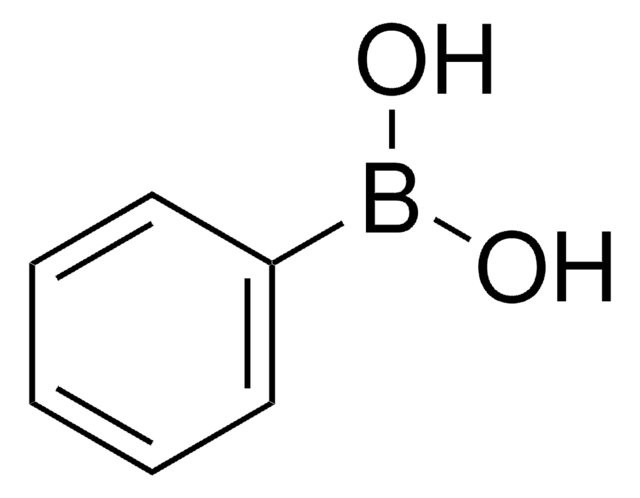8.07471
Polyphosphoric acid
for synthesis
Sinónimos:
Polyphosphoric acid, PPA
About This Item
Productos recomendados
vapor pressure
2 hPa ( 20 °C)
Quality Level
assay
83-87% P2O5 basis (acidimetric)
form
viscous liquid
bp
530 °C/1013 hPa
mp
-20 °C
density
2.06 g/cm3 at 20 °C
storage temp.
2-30°C
SMILES string
[P](=O)(O)(O)O.[p]21[o][p]([o][o]2)[o][o]1
InChI
1S/O5P2.H3O4P/c1-2-7-4-3-6(1)5-7;1-5(2,3)4/h;(H3,1,2,3,4)
InChI key
FVYIVXLIMHNYTD-UHFFFAOYSA-N
General description
Application
- In acylation and alkylation reactions.
- To synthesize cyclic aromatic compounds via cyclization of aromatic acids, esters, ketones, aldehydes, acetals, alcohols, and alkenes.
- In Bischler−Napieralski reaction to construct isoquinoline ring system from phenethylformamides.
- To prepare substituted indoles at position-2 from hydrazones via Fisher indole synthesis.
- For the conversion of oximes into amides via Beckmann rearrangement.
PPA can also be used as a catalyst to synthesize:
- Aniline derivatives by Lossen rearrangement of aromatic carboxylic acids with nitromethane.
- Amides by hydrolysis nitriles.
- Dimethyl carbonate (DMC) from urea and methanol.
- Benzofurans by cyclization of α-phenoxy ketones.
PPA is also used with other reagents for various organic transformations. For example:
- PPA/Ethanethiol mixture can be used to selectively open one epoxide in bis-epoxy steroid.
- PPA/POCl3 catalytic mixture used to convert tertiary alcohols into corresponding chlorides.
- PPA/acetic acid is used to synthesize nonenolizable β-diketones.
- PPA/potassium iodide mixture used to convert primary methyl ether to a primary alkyl iodide.
- PPA/nitric acid catalytic combination used for nitration reactions which is less hazardous than Ac2O/HNO3 mixtures.
Analysis Note
Due to its specific melting range the product may be solid, liquid, a solidified melt or a supercooled melt.
signalword
Danger
hcodes
Hazard Classifications
Eye Dam. 1 - Met. Corr. 1 - Skin Corr. 1B
Storage Class
8B - Non-combustible, corrosive hazardous materials
wgk_germany
WGK 1
flash_point_f
does not flash
flash_point_c
does not flash
Certificados de análisis (COA)
Busque Certificados de análisis (COA) introduciendo el número de lote del producto. Los números de lote se encuentran en la etiqueta del producto después de las palabras «Lot» o «Batch»
¿Ya tiene este producto?
Encuentre la documentación para los productos que ha comprado recientemente en la Biblioteca de documentos.
Nuestro equipo de científicos tiene experiencia en todas las áreas de investigación: Ciencias de la vida, Ciencia de los materiales, Síntesis química, Cromatografía, Analítica y muchas otras.
Póngase en contacto con el Servicio técnico








